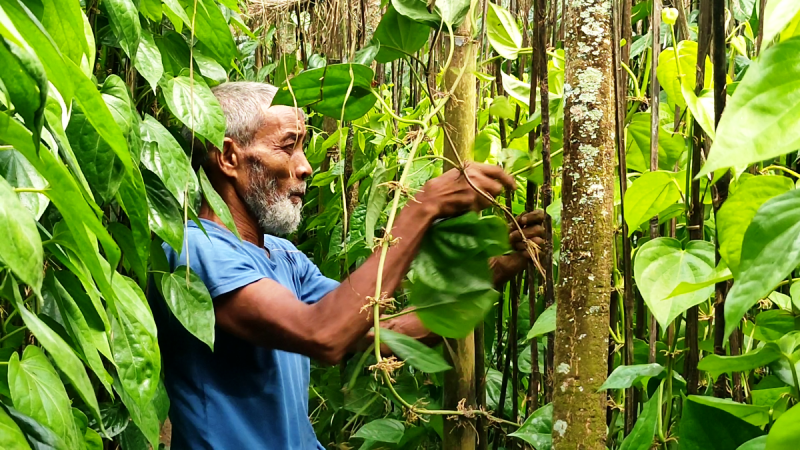- BNP senses ‘dangerous conspiracy’ against democratic transition |
- CEC Vows Credible Election to End Stigma |
- High-level meeting reviews country’s economic progress |
- Dhaka suspends visa, consular services at its Delhi, Agartala Missions |
- Govt to cut savings certificate profit rates from January |
C’nawabganj’s betel leaf don’t fetch fair price for farmers

A betel leaf farmer of Chapainawabganj at work in his farm. UNB
Nasim Mahmud, Chapainawabganj, Oct 8 - In the lush fields of Chapainawabganj, where betel leaves have been nurtured since the days of the British Raj, a bountiful harvest has brought little cheer to the farmers.
Despite an abundant yield this season, the leafy green treasure is failing to fetch fair prices, leaving many cultivators struggling to recover even the cost of production.
Betel leaf cultivation thrives in Sadar and Shibganj upazilas, where generations of farmers have painstakingly tended their gardens.
This year, favourable weather promised a fruitful season, with leaves sprouting in abundance. Yet, instead of smiles, the harvest has brought financial woes, as market prices have tumbled to alarming lows.
Farmers sell betel leaves in units known as ‘pa’n’, each consisting of 80 leaves, with prices varying according to size -- small, medium and large.
Last year, a large-sized pa’n could command Tk 130–140, a medium-sized one Tk 70–90, and a small bundle Tk 25–30.
This year, however, the market paints a dismal picture: large leaves fetch only Tk 30–40, medium ones Tk 12–15, and small leaves barely Tk 2–5.
Abdul Bari, a grower from Jadupur in Sadar upazila, lamented, “This time, there is hardly any price for betel leaves. Although production costs are higher than last year, the price is only one-third. Everything from labour wages to pesticides and husks has gone up. As a result, we are facing losses.”
Similarly, Abdus Salam from Durgapur said, “Last year I sold large-sized betel leaves for Tk 130–140 per pawn. This year, I’m barely getting Tk 30–40. The small ones are practically worthless. We can’t even cover our costs.”
The financial strain is particularly acute for farmers who took loans in anticipation of profits.
Moyez Ali of Jadupur recalled, “Last year, I bought a betel garden by spending Tk 2 lakh and earned Tk 4 lakh. With the same hope, I purchased a field this year as well. Despite high production, I am worried about recovering the principal due to lack of market prices.”
Jayedul Hossain, another grower, borrowed Tk 50,000 from a local NGO for cultivation. “Prices have fallen so dramatically that I doubt I’ll even make half of that back. Now I’m stressed about repaying the loan and supporting my household,” he said.
Yasin Ali, Deputy Director of the Department of Agricultural Extension (DAE) in Chapainawabganj, confirmed that betel leaf cultivation covered approximately 15 hectares this season, slightly less than last year.
“This year’s favourable weather ensured a good yield. However, as the entire produce was sold in the local market, the supply surged, causing prices to plummet. Farmers are being advised to explore alternative markets to secure fair prices,” he said.
As the sun sets over Chapainawabganj’s verdant fields, the leaves shimmer in the evening light, a reminder of nature’s bounty and the fragile fortunes of those who toil to harvest it. - UNB

